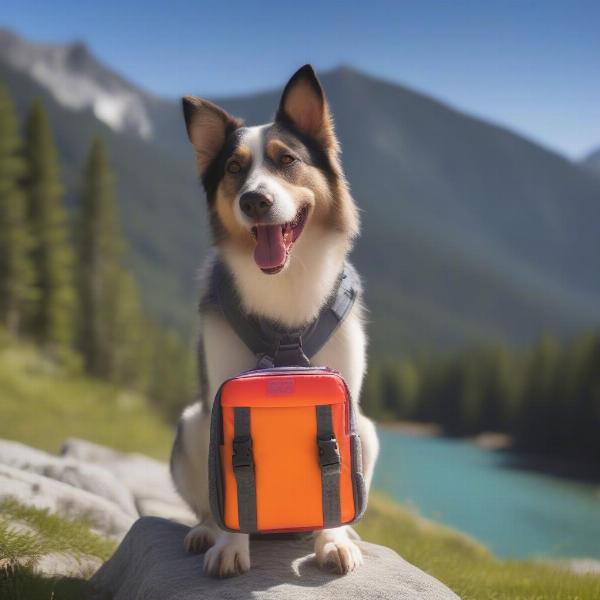Lunchbox dogs are becoming increasingly popular, reflecting a growing trend towards providing our furry friends with convenient and nutritious meals on the go. Whether you’re heading out for a hike, a day at the park, or just a quick errand, a well-packed lunchbox ensures your dog has the energy they need. But what exactly constitutes a “lunchbox dog” and how do you pack the perfect portable meal for your canine companion? This comprehensive guide will provide you with everything you need to know.
Understanding the “Lunchbox Dog” Concept
The term “lunchbox dog” doesn’t refer to a specific breed but rather the practice of packing meals for your dog in a lunchbox-style container, much like you would for yourself. It’s about convenience and ensuring your dog has access to healthy food wherever you go. This approach is especially useful for active dogs, those with dietary restrictions, or simply for making outings with your dog easier and more enjoyable. A properly packed lunchbox can help maintain your dog’s energy levels, prevent hunger-related behavioral issues, and ensure they receive the correct nutrition even when away from home.
 Dog Hiking with Lunchbox
Dog Hiking with Lunchbox
Essential Components of a Dog Lunchbox
Packing a lunchbox for your dog involves more than just tossing some kibble into a container. Consider the following elements to ensure a balanced and enjoyable meal:
- Food: The foundation of any dog lunchbox is the food itself. Choose high-quality kibble, wet food, or homemade meals that meet your dog’s nutritional needs. If using wet or homemade food, consider using a thermos or insulated container to keep it fresh.
- Hydration: Water is crucial, especially during activities. Pack a collapsible bowl or water bottle designed for dogs to ensure they stay hydrated.
- Treats: Small, healthy treats can be used for training, rewards, or simply to add a bit of excitement to the meal.
- Utensils: A portable bowl and spoon or fork can be helpful, especially for wet food or homemade meals.
- Cooling elements: If packing perishable food, include ice packs or frozen water bottles to keep it at a safe temperature.
- Cleanup: Pack some disposable bags for waste and a small towel for cleaning up spills.
Choosing the Right Lunchbox
The market offers a variety of lunchboxes specifically designed for pets. Look for one that is durable, easy to clean, and sized appropriately for your dog’s meals. Some lunchboxes even come with compartments for food, water, and treats, providing ultimate organization.
Tailoring the Lunchbox to Your Dog’s Needs
Just like human lunches, a dog’s lunchbox should be tailored to their individual requirements. Consider factors such as:
- Age: Puppies and senior dogs may have different nutritional needs than adult dogs.
- Activity level: Highly active dogs require more calories and nutrients.
- Dietary restrictions: Dogs with allergies or sensitivities need specially formulated food.
- Climate: In hot weather, pack extra water and cooling elements.
Tips for a Successful Lunchbox Experience
- Introduce the lunchbox gradually: Let your dog sniff and explore the lunchbox before packing it with food.
- Pack familiar foods: Avoid introducing new foods while on the go, as this could upset your dog’s stomach.
- Portion control: Pack appropriate portions to prevent overfeeding.
- Clean the lunchbox regularly: Wash the lunchbox thoroughly after each use to prevent bacterial growth.
Conclusion
The “lunchbox dog” trend is a practical and beneficial approach to feeding your dog on the go. By following these tips and packing a well-balanced lunchbox, you can ensure your canine companion receives the nutrition they need while enjoying all of life’s adventures. A little preparation can make a big difference in your dog’s health and happiness, making your outings together even more enjoyable.
FAQ
- What kind of food is best for a dog lunchbox? High-quality kibble, wet food, or homemade meals that meet your dog’s nutritional needs.
- How do I keep wet food fresh in a lunchbox? Use an insulated container or thermos.
- What should I do if my dog doesn’t want to eat from the lunchbox? Introduce it gradually and pack familiar foods.
- How often should I clean my dog’s lunchbox? After each use.
- Can I pack frozen food in my dog’s lunchbox? Yes, but ensure it thaws completely before feeding.
- What are the best treats to pack in a dog lunchbox? Small, healthy treats suitable for your dog’s age and dietary needs.
- What type of lunchbox is best for dogs? Durable, easy-to-clean, and appropriately sized containers with compartments for food, water, and treats.
ILM Dog is a leading international pet care website dedicated to providing expert advice on dog care and nutrition. We offer comprehensive resources on breed selection, health, training, nutrition, grooming, and much more. For personalized advice and guidance on choosing the right products and accessories for your “lunchbox dog,” contact our team of experts at [email protected] or call us at +44 20-3965-8624. ILM Dog is your trusted partner in providing the best possible care for your furry friend.